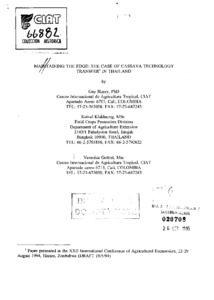Maintaining the edge: the case of cassava technology transfer in Thailand
For more than two decades Thailand has built up an intensive and highly profitable cassava processing and export industry, mainly due to favorable price and quota policy regimes with the European Community (EC). During the 1980`s however, internal EC political pressure has attempted to reduce Thai pellet imports through various measures. Moreover, in 1993 internal EC grain prices were lowered substantially, thereby reducing the relative price advantages of Thai cassava as energy substitute. The subsequent pressure on the Thai cassava sector has resulted in several Thai governmenlal policy measures: (a) reduce cassava area using EC subsidies, (b) diversify cassava products and markets, and (c) reduce cassava production cost through increased varietal technology transfer. To stimulate the latter, significant private (processors) and government funds have been directed to cassava varietal technology transfer. The paper examines adoption characteristics of cassava variety RAYONG 3 (R3) and analyzes with a logistic regression model the different factors that influence (non) adoption based on survey data of 700 cassava farm households in 9 provinces of NE and E Thailand. Results show that both the government and the private cassava sector have played a key role in the technology diffusion process. Hence, this will help to maintain the competitiveness of cassava for export markets.

